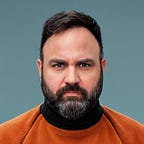Does form follow function?
“Form follows Function — that has been misunderstood. Form and Function should be one, joined in a spiritual union.”
Frank Lloyd Wright
“Form follows function” has been a target of heated discussion since the 18 century in design. It started with the school of thought on functionalism in architecture. For example, the architect Louis Sullivan coined the maxim “a rationally designed structure may not necessarily be beautiful, but no building can be beautiful that does not have a rationally designed structure.”
Making the jump to the UX/CX world, when you design a product solution for a problem, does the Form always follow Function?
With no context, my answer would be yes, nevertheless I believe this question deserves more in-depth thinking.
Who is who?
Let’s start by defining who is who in this conundrum.
We define a form of something like the way it looks. for example:
- a knife can have a full guard, a guard, or no guard at all
- the knife handle could be a solid color, textured, or even with a pattern
- the material used in the knife will have an impact on its Form.
We define the Function of an object as its intended purpose. So, in essence, it is what it does. for example:
- a knife needs to be able to cut
- a knife should be easy to grab
- A knife needs to be able to perform the cut its user needs.
Form follows Function
Since the 18 century, a school of thought in architecture focused on designs where the main focus is to provide an answer to a specific need. This concept translated at the beginning of designing buildings with specific purposes in mind, such as school, public Function, etc.
If we move forward to today’s practices in IT consultancy, regardless of the workflow configuration (agile, waterfall, etc…), the IT teams always have a stage for requirements gathering. The results of the requirements gathering inform the functional context to the design teams to design based on the needs, which will result in a product/deliverable to the client.
This process relies heavily on the correct gathering of requirements and the quality of the requirements gathering teams. The problem here is that these teams focus on the functional needs of the business and disregard the user needs most of the time.
Informed Project managers often build mixed business analysis and UX elements in the requirements teams to improve the quality of the requirements gathering, so they express both business and user needs. Hence, the design follows the business and user needs (Function).
Function follows Form
Function follows Form is a fidgety one, as humans, sometimes we do this naturally cause when designing its easy to follow human emotion, cater to egos disregarding the purpose of the design.
If we focus on the design and disregard the Function, we may have a weird experience for the user. For example, let’s look at a knife that we design to be sleek looking with an internet connection and writes; you have an excellent design study, but is it a knife?
So, if Function follows Form, does it always turn out bad?
it depends!
If we look in the context of IT consultancy, if Function follows Form, the results will be frustrating for the user because it does not focus on the user’s needs and focus on the creator’s view.
Recent studies indicate that if Function follows Form during ideation exercises, it provides a broader space to explore concepts. In this reasoning, when you don’t limit yourself to the execution of an idea, to its purpose, it is easier to explore new ideas that later on may prove inspiring.
Now what?
Looking back is clear to me that context is critical to understand which design strategy should follow.
In the context of consultancy, in a project, Form should always follow Function and even be side by side. This means that reasonable requirements should inform functional and user needs so that we follow the needs and not the teams’ biased view when designing.
Function should follow Form to allow broader exploration of possibilities that will inspire new designs in the context of an investigation.
References
Foto de Olya Kobruseva no Pexels
Foto de Yuri Catalano no Pexels
Foto de Brett Sayles no Pexels
Foto de Christina Morillo no Pexels
Foto de James Wheeler no Pexels
https://en.wikipedia.org/wiki/Louis_Sullivan
https://contentandmindful.com/when-function-follows-form-content-strategy/
http://www.tropicofchoice.com/function-follows-form/
https://visonicdome.com/2020/10/21/form-follows-function/
https://en.wikipedia.org/wiki/Form_follows_function
https://www.thoughtco.com/form-follows-function-177237
Gutheim, Frederick, editor. “Frank Lloyd Wright on Architecture: Selected Writings (1894–1940).” Grosset’s Universal Library, 1941.
Sullivan, Louis H. “The Tall Office Building Artistically Considered.” Lippincott’s Magazine, March 1896.
Wright, Frank Lloyd. “The Future of Architecture.” New American Library, Horizon Press, 1953.
